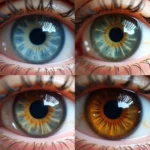Have you ever looked in the mirror and wondered what your true hair color is? Maybe you’ve been coloring it for so long that you can’t remember what it looked like before. Or, perhaps you’re just curious about the subtle nuances of your natural shade. Whatever your reason, discovering your natural hair color can be a fun and enlightening experience.
What Determines Your Natural Hair Color?
Your natural hair color is determined by the amount and type of melanin present in your hair shaft. Melanin is a pigment that gives your hair, skin, and eyes their color. There are two types of melanin that affect hair color:
- Eumelanin: This pigment is responsible for brown and black hair colors. Higher concentrations of eumelanin result in darker shades.
- Pheomelanin: This pigment produces red and yellow hues. People with red hair have a higher concentration of pheomelanin.
The combination of these pigments, along with factors like genetics and environmental exposure, create the unique spectrum of hair colors we see.
 Genetics influencing hair color
Genetics influencing hair color
Signs You Might Not Be Seeing Your True Hair Color
Over time, various factors can alter your hair color, making it difficult to determine your natural shade. Here are some telltale signs that your current hair color might not be entirely natural:
- Your roots are a different color than the rest of your hair. This is the most obvious sign, especially if you dye your hair.
- Your hair has a brassy or faded appearance. Sun exposure, chlorine, and even certain hair products can cause your hair color to change over time.
- You see a mix of different colors in your hair. This can be a sign that your hair has been colored multiple times or that you have naturally occurring highlights.
Effective Ways to Find Your Natural Hair Color
Ready to uncover your true hair color? Try these methods:
1. Examine Your Roots
The hair closest to your scalp is your newest growth and often the best indicator of your natural color. Examine your roots in natural light, looking for variations in shade and undertones.
2. Check Your Baby Photos
Remember those adorable baby pictures? Take a trip down memory lane and look at photos of yourself as a child. Your hair color in childhood is typically closest to your natural shade.
3. Ask Your Family
Genetics play a significant role in determining your hair color. Ask your parents, grandparents, or siblings about their hair color history. You might be surprised by the insights you gain!
 Old photographs showing different hair colors
Old photographs showing different hair colors
4. Consult a Hair Professional
A skilled hairstylist can analyze your hair and provide insights into your natural color. They can assess factors like your skin tone and eye color to determine the shades that would complement your natural features.
Understanding Hair Color Levels and Undertones
Once you have a good idea of your natural hair color, you can further define it by understanding hair color levels and undertones:
- Hair Color Levels: This refers to how light or dark your hair is, typically ranging from level 1 (black) to level 10 (lightest blonde).
- Hair Undertones: These are the subtle hints of color beneath your base color. Common undertones include warm (golden, red, copper), cool (ash, beige), and neutral.
Knowing your hair level and undertone can be incredibly helpful when choosing hair colors, highlights, or even clothing and makeup that best complement your natural coloring.
 Hair color chart with levels and undertones
Hair color chart with levels and undertones
Embrace Your Natural Beauty
Finding your natural hair color is a journey of self-discovery. Whether you choose to embrace your natural shade or enhance it with color, understanding your unique coloring will help you make confident choices that reflect your individual style. Remember, there’s beauty in every shade!
FAQ
1. Can my natural hair color change over time?
Yes, it’s natural for your hair color to change gradually as you age. Hormonal changes, sun exposure, and other factors can contribute to these shifts.
2. What if I can’t remember my natural hair color?
Don’t worry! You can try looking at old photos, asking family members, or consulting a hairstylist for guidance.
3. Is it better to dye my hair to match my natural color?
The choice is entirely yours! Whether you want to embrace your natural color or experiment with different shades is a personal preference.
4. How can I enhance my natural hair color without dyeing it?
There are many ways to enhance your natural color without resorting to permanent dyes. You can try color-depositing shampoos and conditioners, herbal rinses, or highlighting techniques that subtly enhance your existing shade.
5. How do I choose the right hair color if I do want to dye it?
Consider your skin tone, eye color, and personal style when choosing a hair color. It’s often best to consult with a professional stylist for personalized recommendations.
Need Help Choosing the Perfect Colors?
Finding the right colors to complement your natural beauty can be challenging. If you’re looking for expert advice, contact us at [Phone Number]: 0373298888, [Email]: [email protected], or visit us at [Address]: 86 Cầu Giấy, Hà Nội. Our team of color specialists is available 24/7 to assist you. We can help you with:
- How to select lipstick color
- Don’t stop color on the walls
- Where to buy colored lenses
- How to choose the perfect lipstick color
- What is wisteria color
Let us help you unlock your full color potential!

